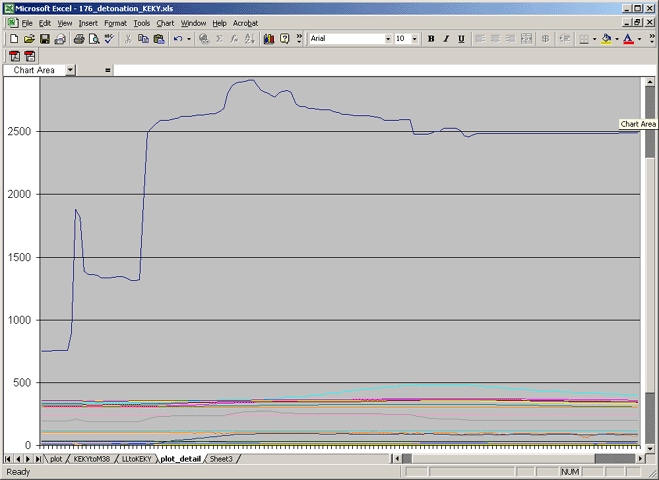Mark Langford's KR2S Project
Detonation
created August 19, 2006
I've always known that detonation in an airplane would be a bad thing, and heard stories such as WW's forced landing in a field only a few miles from an airport because of it. But I'd never experienced it before now. I did a lot of research on combustion chamber design while building my 3100cc engine, and the "new" 2700cc engine gave me the opportunity to use some of it. Conventional wisdom in the Corvair world is to maximize detonation resistance by keeping the quench distance (distance between the flat roof of the chamber and the top of the piston at TDC) to a maximum of .040", with .020 even better, IF your pistons don't hit the head at max rpm, that is. This minimizes the amount of "end gas" that CAN detonate, thereby reducing the possiblity. Lowering the potential for detonation can allow you to burn lower octane fuel. I burn 93 octane auto fuel because 100LL fouls oxygen sensors, rendering air/fuel ratio meters useless, and it creates other deposits that are less than helpful in an engine. That's my main problem with 100LL, but price is also a factor.
Last week I flew down to my father's grass strip, and dropped by to pick my brother along the way. It was a 95 degree day, and I was burning 93 octane auto fuel, as usual. The trip down was uneventful. While there, I refueled with some fuel bought locally, but I didn't actually buy it, so I can't be sure of what it was, but it was SUPPOSED to be 93 octane. But the last time I visited, the guy that bought the fuel remarked that he didn't see why my plane wouldn't burn 87 octane, and I did my best to explain that I was running a carefully calculated 9.3:1 compression ratio, in an environment that is far more hostile than cars usually see, and a hot summer day was not the time to test it! I'm not sure I convinced him.
So we refueled my plane with "whatever", and we took off. Climbout was uneventful, and I landed in Birmingham to drop my brother off. I only switched it off for a minute, shook hands, said "see ya later" and off I went again. The difference in this takeoff and the previous one is that now the engine was hot, oil temp was high, oil pressure was low, and the fuel in the lines "might" have been something less than 93 octane. I ended up waiting for two airplanes to land before I took off, so I sat idling for about 3-4 minutes before takeoff.

Looking back at the EIS data, I now know that 5 seconds after I opened the throttle for takeoff the head temperature for number three started climbing at about 3 degrees per second. And when I lifted off about 13 seconds later, the engine wasn't running smoothly. I kept on climbing and checked the usual suspects, such as mixture setting and air/fuel ratio gauge, and those seemed about right. The engine wasn't misfiring, but it was definitely down on power, about like 5-cylinder mode, and there was an unmistable vibration. I really thought the crank might be about to break, so I backed off the throttle a little and lowered the nose a little. This was at about 130' off the ground, and I started a shallow circle back to the runway.

At about that time the EIS warning light lit up, and the tone in the headsets told me something really was wrong. Most of the things the EIS warns you about can be dealt with, at least, and one glance over there showed the CHT for number 3 at flashing 485 degrees! In less than a minute, that cylinder went from 330 degrees to 485, and the only thing I know of that will cause such a rapid increase in CHT is detonation. The snapshot plot above shows rpm in dark blue, and CHT #3 as the little mountain down around 500 degrees.
So I backed off the throttle some more and turned downwind and back towards the runway. It's hard to back off and quit climbing when you're that low, especially when there's nothing below you but trees! Backing off the throttle lowers the density of the combustion charge, lowering combustion chamber pressures, and taking away one of the conditions that make detonation possible (high pressure, high temperature, or low octane fuel). When the engine got quieter due to the lower throttle setting I could hear it ping, verifying that it was detonation, but then the detonation stopped and the alarm quit flashing. I was still limping along the treetops parallel to the runway but knew I would be OK if I just let it cool off, so I circled once over the end of the runway, watching the head temps drop just as fast as they'd come up. So I did what any dumb pilot would do and climbed out gradually, and flew the rest of the way home without event, but never running full throttle.
I drained the fuel when I got back, and will run it in the Karmann Ghia. That thing might as well be a CFR (combustion fuel research) engine, because with its 8.9:1 compresion ratio, it can smell 91 octane a mile away!
There are probably several morals to this story:
Make sure you KNOW what kind of fuel is going in your plane
Burning 100LL would have kept this incident from happening at all
A CHT probe on just ONE cylinder won't do diddly for you when it comes to recognizing detonation, unless you're a gambling man (1:6 odds)
Something with an alarm function like an EIS (Engine Information System) can definitely save your butt. Some folks argue that they offer too much information to sort through to be of any use. This thing is constantly looking for problems, and when it finds one, it beats me over the head and tells me exactly what it is in less than a second. I call it a lifesaver. That's about three times for me, but then I've just packed 10 years of flying into a single year.
My CHT alarm trigger point was set too high. It's now set for 400F, since I've never seen anything higher than that since I've been flying it. It was set to 475F before, due to my limited ground testing experience where I'd run it forever at high rpm while sitting on the ground. My CHTs are read at the sparkplug.
There are a few interesting observations to be made here. The cylinder that detonated wasn't the hottest, two others on the other bank were 20 degrees hotter when it started. Next time I'm in there I'll look for potential hot spots due to sharp edges. It also wasn't the highest EGT either, and you might could argue that it was lean of peak, but going back to the data, it never got to peak. And notice how the neighboring cylinders 1 and 5 started to climb through heat conduction. In another minute I'd have probably had three detonating cylinders, and I'd have gone down in the trees. The crank thing taught me that anything can happen when you least expect it, and this is just another one of those things that can make you into a glider pilot in a hurry. Stay alert...
Return to Mark Langford's KR2S Corvair

